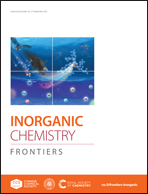Metal–organic architectures designed from a triphenyl-pentacarboxylate linker: hydrothermal assembly, structural multiplicity, and catalytic Knoevenagel condensation†
Abstract
A triphenyl-pentacarboxylic acid, 3,5-di(2′,4′-dicarboxylphenyl)benzoic acid (H5ddba), was applied as an adaptable linker for the hydrothermal assembly of eight new metal(II) coordination polymers (CPs) and complexes, formulated as [Cu2(μ-H3ddba)2(phen)2] (1), {[Cd2(μ4-Hddba)(phen)2(H2O)2]·2H2O}n (2), [M4(μ3-Hddba)2(2,2′-bipy)6(μ-H2O)]·6H2O (M = Ni (3), Mn (4)), {[Co2(μ5-Hddba)(μ-4,4′-bipy)1.5(H2O)]·H2O}n (5), {[Zn2(μ5-Hddba)(4,4′-bipy)1.5]·4,4′-bipy·2H2O}n (6), [Mn2(μ6-Hddba)(H2biim)(H2O)]n (7), and {[Cd2(μ7-ddba)(Hbpa)]·5H2O}n (8). The products 1–8 were generated from metal(II) chlorides, H5ddba, and various N-donor supporting ligands acting as mediators of crystallization (i.e., phen: 1,10-phenanthroline; 2,2′-bipy: 2,2′-bipyridine; 4,4′-bipy: 4,4′-bipyridine; H2biim: 2,2′-biimidazole; or bpa: bis(4-pyridyl)amine). All compounds were analyzed by standard methods (C/H/N analysis, FTIR, TGA and PXRD) including single-crystal X-ray diffraction. The structural multiplicity of 1–8 ranges from discrete dimers (1) or tetramers (3 and 4) to a 1D coordination polymer (2) and 3D metal–organic frameworks (5–8). Topological analysis of simplified H-bonded or metal–organic networks disclosed fcu (1), 2C1 (2), dia (3 and 4), sra (6), 3,4,7T3 (8), and unprecedented (5 and 7) topologies. The catalytic activity of 1–8 was investigated in a model Knoevenagel condensation between benzaldehydes and malononitrile, resulting in up to 99% yields of condensation products. The substrate scope, catalyst recycling, and effects of different reaction parameters were investigated. Finally, this work extends the use of H5ddba as an aromatic pentacarboxylate building block for the design of new metal–organic architectures with captivating structures and functional properties.



 Please wait while we load your content...
Please wait while we load your content...